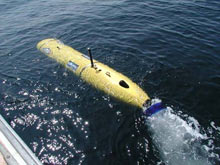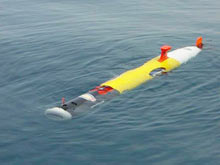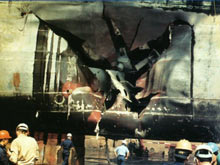
The battleship preparation autonomous underwater vehicle (BPAUV) is part of the mine countermeasures mission module delivered to the USS Freedom in 2007. Click image for larger view and image credit.
The REMUS autonomous underwater vehicle (AUV) helped clear the Iraqi port Umm Qasr in 2003. This was the first successful wartime deployment of an AUV. REMUS AUVs are still in operation throughout the world. Click image for larger view and image credit.
Underwater Mines
Colin Babb
Communications Specialist
U.S. Navy's Office of Naval Research
The U.S. Navy's Office of Naval Research (ONR) has invested in autonomous underwater vehicle (AUV) and mine countermeasures technologies to address a long-standing threat that remains very real today: underwater mines. Since World War II, more U.S. Navy ships have been damaged or lost due to mines than to all other causes combined.
Underwater mines come in a variety of different types, from bottom mines that sit on the sea floor, to magnetic mines that explode in close proximity to ships, to mobile and homing mines. Mines can either explode themselves or be essentially canisters that fire a torpedo at their targets. Contact mines that use World War I-era technology are still in use, and just as deadly as ever. Building mines today is both easy and inexpensive, and they are more difficult to detect and counter than ever before. Consequently, mine countermeasures remains a tedious, labor-intensive, and dangerous job that puts personnel and vessels in harm’s way.
ONR is hard at work on a wide range of autonomous vehicles, sensors, and other technologies designed to search for, classify, and neutralize or destroy sea mines. The vehicle REMUS, an ONR technology, helped clear the Iraqi port of Umm Qasr in 2003; and it is used by mine clearance and explosive ordnance disposal professionals around the world. In 2007, ONR delivered the mine countermeasures mission module to the first littoral combat ship, the USS Freedom (LCS-1). The module is composed of the battlespace preparation autonomous underwater vehicle (BPAUV), designed by ONR, as well as other technology. Current research focuses on making the AUVs of tomorrow smaller, smarter, and better able to communicate and work with each other while accomplishing more tasks on their own.
In 1991, the USS Tripoli sustained a 16- x 20-foot hole below the water line from a contact mine. Click image for larger view and image credit.
Since 1997, the ONR has sponsored AUVfests to expose both the defense and scientific communities to technical advances and common applications in AUV technology. During this year’s AUVfest, a select group of AUVs will conduct mine countermeasure operations, which will include buried mine hunting, mine neutralization, and search-classify-map activities. Both the REMUS and the BPAUV will be among the AUVs participating.
ONR vehicles and sensors have applicability to a range of civilian missions, from exploring shipwrecks to conducting environmental research. AUVfest 2008 is focusing on the dual objectives of demonstrating both mine countermeasure operations and marine archaeological explorations. Using mine countermeasures know-how and equipment for archaeological purposes is likely to lead to improved understanding of the underlying technology, benefiting both the defense and scientific communities.
Sign up for the Ocean Explorer E-mail Update List.

















